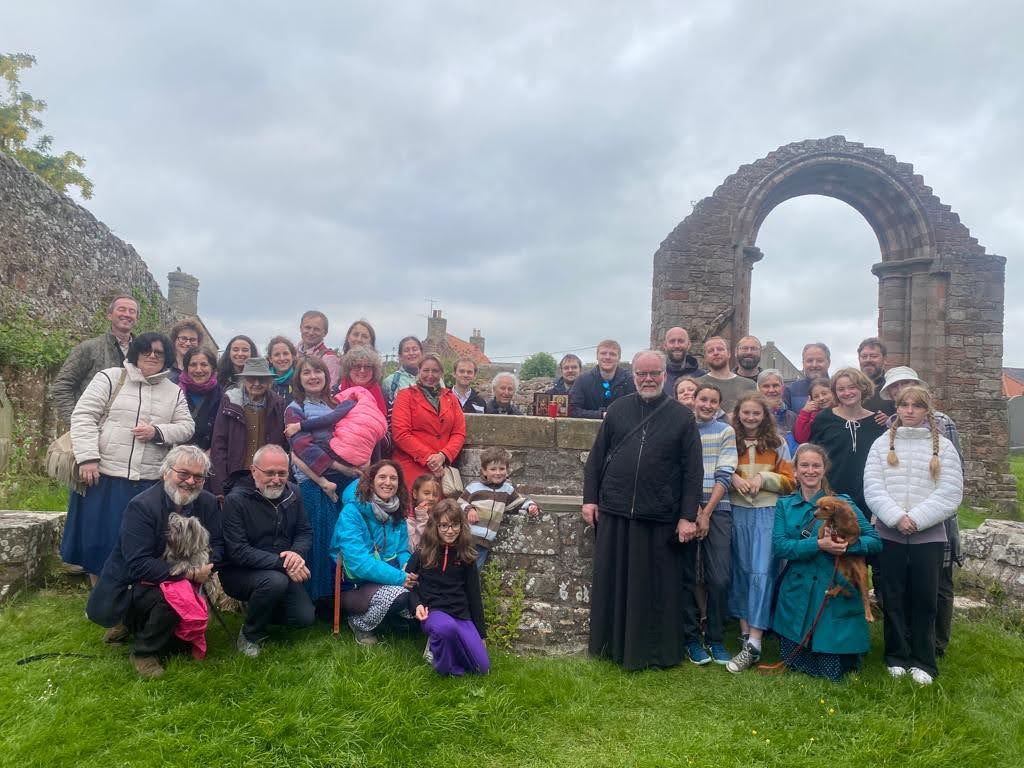« Pilgrimage to the holy places of Northumbria and Mercia »
 04-06-2023
04-06-2023  From Monday, May 29 to Friday, June 2, 2023, with the blessing of His Grace Bishop Matthew of Sourozh, a group of parishioners of the church of St. Nicholas the Wonderworker in Oxford made a pilgrimage to the holy places of North-East England. The pilgrimage group was led by the Rector of the church, Archpriest Stephen Platt, Dean of the Diocesan District of Central England.
From Monday, May 29 to Friday, June 2, 2023, with the blessing of His Grace Bishop Matthew of Sourozh, a group of parishioners of the church of St. Nicholas the Wonderworker in Oxford made a pilgrimage to the holy places of North-East England. The pilgrimage group was led by the Rector of the church, Archpriest Stephen Platt, Dean of the Diocesan District of Central England.
During the first stop in Lichfield, the pilgrims visited the majestic cathedral of St. Chad, Bishop of Lichfield (+ 672), where they venerated the relics of St. Chad. After visiting the holy spring located near the cathedral, the pilgrims headed north, to the Cathedral of Ripon, where they visited the ancient crypt, preserved from the time of St. Wilfrid, Archbishop of York (+709), the builder of the church. The pilgrims spent the night in the small town of Hexham.
The next morning, the pilgrims made a tour of Hexham Abbey, a monastery associated with the names of many Saints of the undivided Church: St. Paulinus, Bishop of York (+644) and St. Wilfrid, Archbishop of York (+709), St. Aidan, Bishop of Lindisfarne, Apostle of Northumbria (+651), St. Cuthbert, Bishop of Lindisfarne (+ 687), St. John, Bishop of Beverley (+721), martyr Edwin, King of Northumbria (+633), martyr Oswald, King of Northumbria (+642), Holy Hierarch Acca, Bishop of Hexham (+740/742), Holy Hierarch Eata of Hexham and Lindisfarne (+686), St. Bede the Venerable (+735), St. Etheldreda, abbess of the monastery in Ely (+679) and other saints of God. The pilgrims heard all about the history of lives of the ancient Saints of Northumbria and sung a molieben to them.
In the afternoon, the pilgrims visited the archaeological site of Vindolanda, an ancient Roman military camp located near Hadrian's Wall. Thousands of artefacts, including items from the early Christian period, have been unearthed during archaeological research, which continues to this day, and the foundations of three Christian churches have been excavated. At the end of the second day of the pilgrimage, a water-blessing molieben was served at the spring of St. Ninian, Bishop of Whithorn (+432), located in the village of Holystone. At this holy spring, next to which a large Roman highway passed in ancient times, St. Ninian, during his missionary expeditions, baptized many thousands of members of local tribes and, subsequently, received the title of "Apostle of the Picts".
On Wednesday, the Divine Liturgy was celebrated in the ancient church of the XI century in honour of St. Gregory the Great, Pope of Rome, in the village of Kirknewton, after which the pilgrims visited the nearby Ad-Gefrin National Park and the royal residence of the rulers of Northumbria. It is known that at Easter of 627 AD, St. Paulinus, Bishop of York, baptized thousands of people in this place. After lunch, the group visited the church in Norham, to where, according to church legend, the relics of St. Cuthbert of Lindisfarne were taken for safety during the invasion of the Vikings, and Coldingham, where St. Cuthbert prayed in icy sea water, being warmed by sea otters. In those holy places, short moliebens were served and magnifications were sung to the holy Saints of God.
On Thursday, the group travelled to Lindisfarne, also known as the Holy Island, the cradle of Christianity in the north of England. The pilgrims served a molieben in the old parish church of the 11th century overlooking the island of St. Cuthbert, where the Saint of God prayed in complete solitude, and then examined the ruins of the monastery and adjacent monastic buildings. The pilgrims then visited the resting place of St. Aidan in Bamburgh and the cave of St. Cuthbert.
The last day of the pilgrimage ended with a visit to Jarrow and Durham. In the abbey of St. Peter and St. Paul in Monkwearmouth-Jarrow, founded in the 7th century, which was the home monastery of St. Bede the Venerable, pilgrims visited the church of the Holy Apostle Paul, which includes preserved parts of the original building of the Saxon period.
In the majestic Cathedral of Durham, a molieben was served at the tombs of St. Cuthbert and St. Bede the Venerable, where their holy relics rest under a bushel. Then the pilgrims toured the sacristy and treasury of the Cathedral, where they could see the famous pectoral cross of St. Cuthbert, parts of his original coffin, his Gospel, vestments and other items related to the life of the Saint.
The pilgrims were able to communicate with representatives of the Orthodox community in Durham, after which they left for Oxford.






